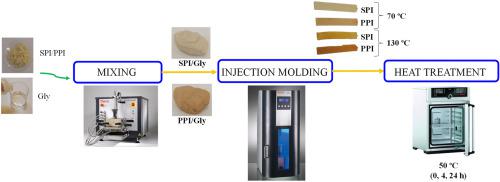Sustainable Chemistry and Pharmacy ( IF 5.5 ) Pub Date : 2020-10-29 , DOI: 10.1016/j.scp.2020.100341 M. Jiménez-Rosado , J.F. Rubio-Valle , V. Perez-Puyana , A. Guerrero , A. Romero

|
The production of bioplastics from renewable and biodegradable sources could be a great potential option for the substitution of conventional plastics. In this way, raw materials and processing method have been investigated to improve their competitiveness in the actual market. However, the extra treatment that bioplastics must undergo to improve their properties are expensive, making them unfeasible. In this sense, a heat treatment in a conventional oven seems to be a potential low-cost option. This work aimed to evaluate the incorporation of a heat treatment at 50 °C in the process of protein-based bioplastic. For this, two proteins with different applications, absorption in hygiene (soy protein isolate) and food packaging (pea protein isolate), were selected to evaluate the versatility of this tentative post-treatment. In addition, two different mold temperatures (70 and 130 °C) and different exposure times of heat treatment (0, 4 and 24 h) were studied to evaluate the effect of them in the bioplastics properties and to select the most optimal processing method for each protein. In this context, mechanical properties and water uptake capacity were evaluated to study the influence of this post-treatment on them. The results showed that the processing conditions and the heat post-treatment could modulate the final properties of protein-based bioplastics, being potential materials to replace conventional plastics.
中文翻译:

使用热处理来开发基于蛋白质的生物塑料
由可再生和可生物降解来源生产生物塑料可能是替代常规塑料的巨大潜在选择。通过这种方式,对原材料和加工方法进行了研究,以提高它们在实际市场中的竞争力。但是,生物塑料必须进行额外的处理以改善其性能是昂贵的,从而使其不可行。从这个意义上讲,在常规烤箱中进行热处理似乎是一种潜在的低成本选择。这项工作旨在评估在基于蛋白质的生物塑料过程中在50°C下进行热处理的过程。为此,选择了两种具有不同应用的蛋白质,即在卫生方面的吸收(大豆蛋白分离物)和食品包装(豌豆蛋白分离物),以评估该试验性后处理的多功能性。此外,研究了两种不同的模具温度(70和130°C)和不同的热处理时间(0、4和24 h),以评估它们在生物塑料特性中的作用,并为每种蛋白质选择最佳的加工方法。在这种情况下,对机械性能和吸水能力进行了评估,以研究这种后处理对其的影响。结果表明,加工条件和热后处理可以调节蛋白质基生物塑料的最终性能,是替代常规塑料的潜在材料。评价机械性能和吸水能力以研究该后处理对其的影响。结果表明,加工条件和热处理可以调节蛋白质基生物塑料的最终性能,是替代常规塑料的潜在材料。评价机械性能和吸水能力以研究该后处理对其的影响。结果表明,加工条件和热后处理可以调节蛋白质基生物塑料的最终性能,是替代常规塑料的潜在材料。











































 京公网安备 11010802027423号
京公网安备 11010802027423号